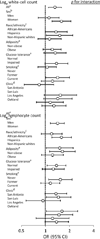Differential white cell count and incident type 2 diabetes: the Insulin Resistance Atherosclerosis Study
- PMID: 24141640
- PMCID: PMC3969879
- DOI: 10.1007/s00125-013-3080-0
Differential white cell count and incident type 2 diabetes: the Insulin Resistance Atherosclerosis Study
Abstract
Aims/hypothesis: White cell count has been shown to predict incident type 2 diabetes, but differential white cell count has received scant attention. We examined the risk of developing diabetes associated with differential white cell count and neutrophil:lymphocyte ratio and the effect of insulin sensitivity and subclinical inflammation on white cell associations.
Methods: Incident diabetes was ascertained in 866 participants aged 40-69 years in the Insulin Resistance Atherosclerosis Study after a 5 year follow-up period. The insulin sensitivity index (SI) was measured by the frequently sampled IVGTT.
Results: C-reactive protein was directly and independently associated with neutrophil (p < 0.001) and monocyte counts (p < 0.01) and neutrophil:lymphocyte ratio (p < 0.001), whereas SI was inversely and independently related to lymphocyte count (p < 0.05). There were 138 (15.9%) incident cases of diabetes. Demographically adjusted ORs for incident diabetes, comparing the top and bottom tertiles of white cell (1.80 [95% CI 1.10, 2.92]), neutrophil (1.67 [1.04, 2.71]) and lymphocyte counts (2.30 [1.41, 3.76]), were statistically significant. No association was demonstrated for monocyte count (1.18 [0.73, 1.90]) or neutrophil:lymphocyte ratio (0.89 [0.55, 1.45]). White cell and neutrophil associations were no longer significant after further adjusting for family history of diabetes, fasting glucose and smoking, but the OR comparing the top and bottom tertiles of lymphocyte count remained significant (1.96 [1.13, 3.37]). This last relationship was better explained by SI rather than C-reactive protein.
Conclusions/interpretation: A lymphocyte association with incident diabetes, which was the strongest association among the major white cell types, was partially explained by insulin sensitivity rather than subclinical inflammation.
Figures


Similar articles
-
White blood cell subtypes, insulin resistance and β-cell dysfunction in high-risk individuals--the PROMISE cohort.Clin Endocrinol (Oxf). 2014 Oct;81(4):536-41. doi: 10.1111/cen.12390. Epub 2014 Jan 16. Clin Endocrinol (Oxf). 2014. PMID: 24372524
-
Investigation of the correlation between some immune system and biochemical indicators in patients with type 2 diabetes.Hum Antibodies. 2016 Jun 8;24(1-2):25-31. doi: 10.3233/HAB-150290. Hum Antibodies. 2016. PMID: 27472870
-
Association of lower vitamin D levels with inflammation and leucocytes parameters in patients with and without diabetes mellitus undergoing coronary angiography.Eur J Clin Invest. 2021 Apr;51(4):e13439. doi: 10.1111/eci.13439. Epub 2020 Nov 20. Eur J Clin Invest. 2021. PMID: 33112413
-
Inflammation in the Prediction of Type 2 Diabetes and Hypertension in Healthy Adults.Arch Med Res. 2017 Aug;48(6):535-545. doi: 10.1016/j.arcmed.2017.11.010. Epub 2017 Dec 6. Arch Med Res. 2017. PMID: 29221802
-
Role of neutrophils in type 2 diabetes and associated atherosclerosis.Int J Biochem Cell Biol. 2021 Dec;141:106098. doi: 10.1016/j.biocel.2021.106098. Epub 2021 Oct 13. Int J Biochem Cell Biol. 2021. PMID: 34655814 Free PMC article. Review.
Cited by
-
White blood cells and type 2 diabetes: A Mendelian randomization study.PLoS One. 2024 Mar 1;19(3):e0296701. doi: 10.1371/journal.pone.0296701. eCollection 2024. PLoS One. 2024. PMID: 38427644 Free PMC article.
-
Red blood cell distribution width and the risk of being in poor glycemic control among patients with established type 2 diabetes.Ther Clin Risk Manag. 2018 Feb 14;14:265-273. doi: 10.2147/TCRM.S155753. eCollection 2018. Ther Clin Risk Manag. 2018. PMID: 29497303 Free PMC article.
-
The role of peripheral white blood cell counts in the association between central adiposity and glycemic status.Nutr Diabetes. 2024 May 17;14(1):30. doi: 10.1038/s41387-024-00271-9. Nutr Diabetes. 2024. PMID: 38760348 Free PMC article.
-
Diabetic Vasculopathy: Molecular Mechanisms and Clinical Insights.Int J Mol Sci. 2024 Jan 9;25(2):804. doi: 10.3390/ijms25020804. Int J Mol Sci. 2024. PMID: 38255878 Free PMC article. Review.
-
Associations of Circulating Lymphocyte Subpopulations with Type 2 Diabetes: Cross-Sectional Results from the Multi-Ethnic Study of Atherosclerosis (MESA).PLoS One. 2015 Oct 12;10(10):e0139962. doi: 10.1371/journal.pone.0139962. eCollection 2015. PLoS One. 2015. PMID: 26458065 Free PMC article.
References
-
- Donath MY, Shoelson SE. Type 2 diabetes as an inflammatory disease. Nat Rev Immunol. 2011;11:98–107. - PubMed
-
- Wu H, Ghosh S, Perrard XD, et al. T cell accumulation and regulated on activation, normal T cell expressed and secreted upregulation in adipose tissue in obesity. Circulation. 2007;115:1029–1038. - PubMed
-
- Larsen CM, Faulenbach M, Vaag A, et al. Interleukin-1-receptor antagonist in type 2 diabetes mellitus. N Engl J Med. 2007;356:1517–1526. - PubMed
Publication types
MeSH terms
Substances
Grants and funding
LinkOut - more resources
Full Text Sources
Other Literature Sources
Medical
Research Materials

